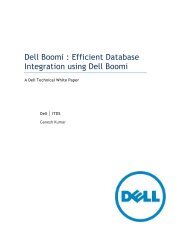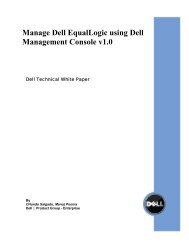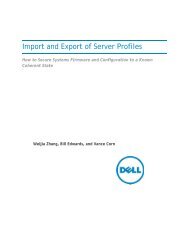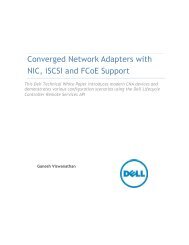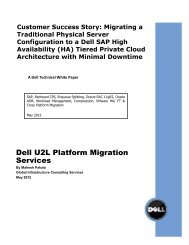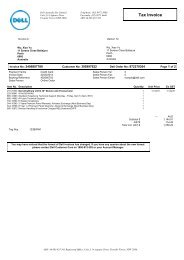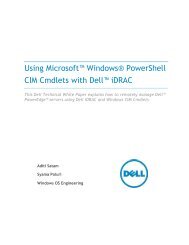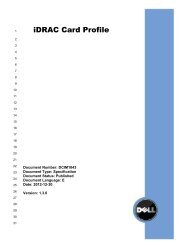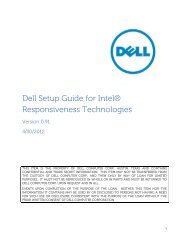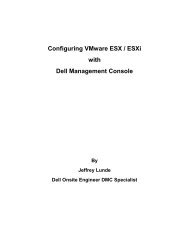BIOS Performance and Power Tuning Guidelines ... - Dell Community
BIOS Performance and Power Tuning Guidelines ... - Dell Community
BIOS Performance and Power Tuning Guidelines ... - Dell Community
Create successful ePaper yourself
Turn your PDF publications into a flip-book with our unique Google optimized e-Paper software.
Normalized <strong>Performance</strong><br />
<strong>BIOS</strong> <strong>Performance</strong> <strong>and</strong> <strong>Power</strong> <strong>Tuning</strong> <strong>Guidelines</strong> for <strong>Dell</strong> <strong>Power</strong>Edge 12th Generation Servers<br />
latency improvement offered, but again this is a special case <strong>and</strong> is not recommended for most<br />
computing environments.<br />
In Figure 10, we see that for a range of integer workloads, which is a subset of server workloads<br />
contained in the SPECint_rate_base2006 benchmark, enabling Logical Processors provides an uplift of<br />
between 9% <strong>and</strong> 34%. The most impacted benchmark by far is 445.gobmk (an Artificial Intelligence<br />
workload based on the game Go) at 34%. For 403.gcc (a GNU C Compiler workload), the uplift for HT<br />
mode was measured at 19%. For 456.hmmer (a Gene Sequencing workload) <strong>and</strong> 462.libquantum (a<br />
quantum cryptography/prime factorization benchmark), the differences were between 11% <strong>and</strong> 9% in<br />
favor of HT on.<br />
Figure 10.<br />
Logical Processor performance on integer workloads<br />
Logical Processor Effects on<br />
Integer Workloads<br />
1.60<br />
1.40<br />
1.20<br />
1.34<br />
1.00<br />
0.80<br />
1.00<br />
1.19<br />
1.00<br />
1.11<br />
1.00<br />
1.09<br />
1.00<br />
HT ON<br />
0.60<br />
HT OFF<br />
0.40<br />
0.20<br />
0.00<br />
445.gobmk 403.gcc 456.hmmer 462.libquantum<br />
Integer Workloads<br />
In Figure 11, the impact of Hyper-Threading is contrasted across several floating-point workloads that<br />
are part SPECfp_rate_base2006. The impacts are quite varied depending on the workload executed.<br />
The workloads measured with the largest positive impact for Hyper-Threading was 447.dealII (a Finite<br />
Analysis workload). Similarly, 435.gromacs (a Biochemistry/Molecular Dynamics workload) saw a 22%<br />
performance gain with HT enabled. For 470.lbm (a Computational Fluid Dynamics workload), no<br />
discernable difference was detected between HT on <strong>and</strong> off. For 436.cactusADM (a Computational<br />
Electromagnetics workload), a 10% decline in performance was measured with HT on compared to HT<br />
off. Caution should be shown when considering disabling of HT unless the workloads planned to be<br />
run on the system are known to benefit from HT off, as the vast majority of tested workloads show<br />
benefit from enabling this option.<br />
17




